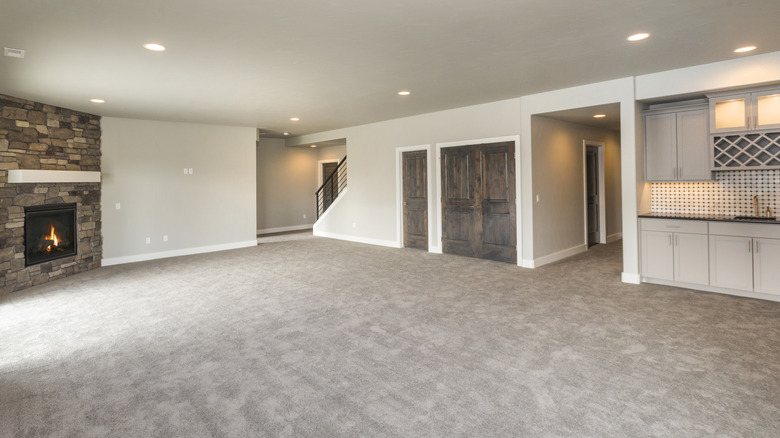Is It Safe To Install Carpet Flooring In The Basement? Here's What Mike Holmes Jr. Says
The debate over the best type of flooring for basements is a contentious one. From vinyl to wood and carpet, the top choice depends on who you ask but also on your unique criteria. For example, while HGTV's Mike Holmes recommends vinyl for a basement remodel, he has openly recognized that budget can be a major deciding factor, which is why Holmes also approves of carpeting when working with a tight budget. Indeed, the upfront cost of installing carpet can be a whopping 50% to 75% cheaper than hardwood, even if its overall lifespan is shorter.
While some folks may warn against using carpet in a basement due to moisture concerns, Mike Holmes Jr. is all for it — as long as it's installed correctly to protect it from getting wet. Since concrete is a porous material, it lets moisture in, which, in turn, can seep into carpet, sparking mold growth. However, there is a simple way to avoid this. "The proper subfloor, like the panelized Amvic system, will allow any moisture that does enter, to harmlessly vent out, without creeping through to your carpet," the handyman shared on his dad's Make It Right blog. Indeed, Amvic's insulated subfloor panels are specifically made to be installed on concrete and wick moisture away through a combination of High Impact Polystyrene (HIPS) film and drainage channels.
Keeping moisture in mind when installing carpet in a basement
In addition to investing in proper subflooring, there are a number of other criteria to keep in mind to safely lay carpet in your basement. With each of these, the overarching goal is to ensure that the space is completely dry before you start work and that moisture remains at bay once you're done.
First, check for cracks in the concrete, as these can allow moisture to get in and wreak havoc on carpeting. While hairline cracks can be ignored, anything wider than ⅛ of an inch will need to be sealed. If the crack is small, you can do a DIY repair using concrete caulk. However, any considerable fissures should be checked out by a professional. Another good spot to check is the cove joint, i.e., the spot where the basement floor meets the wall, as this is prone to leaks. For optimum dryness, a pro can install an interior drainage and sump pump system to catch and remove water before it causes any damage.
Finally, ensure that any windows or doors in the basement are well sealed, and consider investing in a dehumidifier. Run it to fully remove moisture from the space before laying down the carpet, then use it regularly to keep the basement dry and (as a bonus) the air clean.

